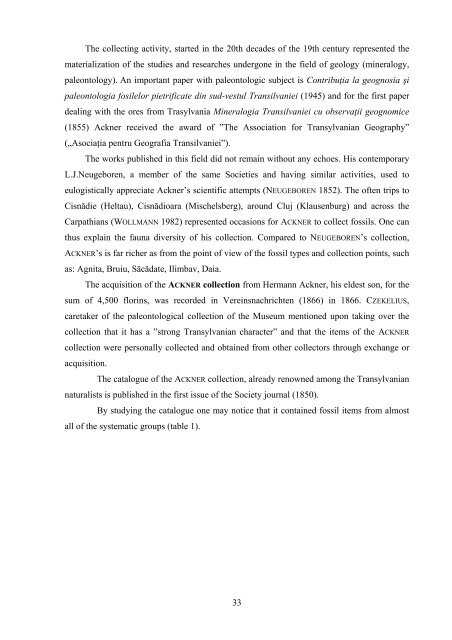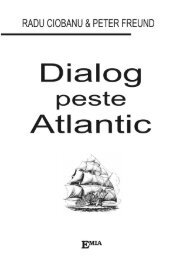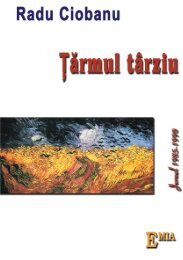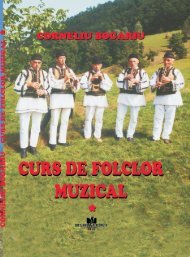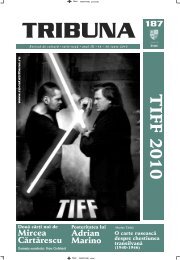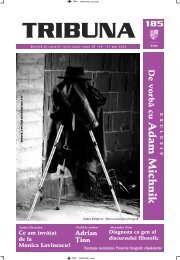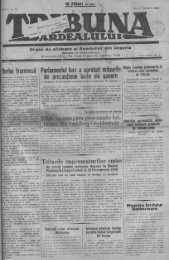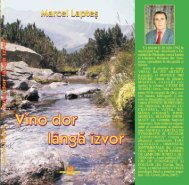The collecting activity, started in the 20th decades of the 19th century represented thematerialization of the studies and researches undergone in the field of geology (mineralogy,paleontology). An important paper with paleontologic subject is Contribuţia la geognosia şipaleontologia fosilelor pietrificate din sud-vestul Transilvaniei (1945) and for the first paperdealing with the ores from Trasylvania Mineralogia Transilvaniei cu observaţii geognomice(1855) Ackner received the award of ”The Association for Transylvanian Geography”(„Asociaţia pentru Geografia Transilvaniei”).The works published in this field did not remain without any echoes. His contemporaryL.J.Neugeboren, a member of the same Societies and having similar activities, used toeulogistically appreciate Ackner’s scientific attempts (NEUGEBOREN 1852). The often trips toCisnădie (Heltau), Cisnădioara (Mischelsberg), around Cluj (Klausenburg) and across theCarpathians (WOLLMANN 1982) represented occasions for ACKNER to collect fossils. One canthus explain the fauna diversity of his collection. Compared to NEUGEBOREN’s collection,ACKNER’s is far richer as from the point of view of the fossil types and collection points, suchas: Agnita, Bruiu, Săcădate, Ilimbav, Daia.The acquisition of the ACKNER collection from Hermann Ackner, his eldest son, for thesum of 4,500 florins, was recorded in Vereinsnachrichten (1866) in 1866. CZEKELIUS,caretaker of the paleontological collection of the Museum mentioned upon taking over thecollection that it has a ”strong Transylvanian character” and that the items of the ACKNERcollection were personally collected and obtained from other collectors through exchange oracquisition.The catalogue of the ACKNER collection, already renowned among the Transylvaniannaturalists is published in the first issue of the Society journal (1850).By studying the catalogue one may notice that it contained fossil items from almostall of the systematic groups (table 1).33
Table 1Fossils – systematic groupsPlantsSponges, coralsEchinodermesCephalopodesBrachiopodsgastropodsCrustaceansBivalvePlaces of collectingDaia, Săcădate, Cornăţel, Glâmboaca, Băile LăpuşSăcele, Zărneşti, Braşov, Turnu Roşu, DobârcaTurnu Roşu, Cisnădioara, Cluj,Cisnădioara, Săcel, BraşovBraşov, Turnu RoşuTurnu RoşuTurnu RoşuTurnu Roşu, DobârcaIn a paper referring to the mineralogical and paleontological collections fromTransylvania, NEUGEBOREN (1866), eulogistically talked about the ACKNER collection andpointed out that it was bought with the support of the ”National Saxon House and of theSocieties: ”the Transylvanian Society for the Study of Nature from Sibiu” (SiebenbürghischeVerein für Naturwissenschaften zu Hermannstadt) and ”the Society for the Study ofTransylvania” (Verein für Siebenbürgische Landeskunde)(Verhandlungen, 1867). In 1867 thedoubles of the ACKNER collection were given to the Evangelic School from Sibiu(Verhandlungen, 1867:1). The collection was enlarged at a short time after the acquisition.Thus, NEUGEBOREN, as caretaker of the paleontological collections, thanks in a meeting of theSociety to CZEKELIUS and MOEKESCH for the enlargement of the ACKNER collection withfossils from the surroundings of Cluj and Alba Iulia (Verhandlungen, 1867:238).NEUGEBOREN mentioned in 1866 that in the ACKNER collection there were 3,791 itemsout of which 1, 728 were fossils (geognostical items) in which the following wererepresented: the ”diluvia from Guşteriţa, the petrified plants from Thalheim – Daia- tertiary,Sebeşul de Sus, Porceşti (lower tertiary), Cisnădioara (chalk formation and Gosau), Răşinari”.The collection also included fossils belonging to the 1,315 species, the most valuable beingthose from Guşteriţa (mammal bones), from the Hârtibaciu Valley (plants, fossil fish,mammal bones), the Braşov area (certain corals), Săcădate (plants, tertiary fish), Turnu Roşu(Porceşti), Cisnădioara, Buituri, Racoş, Muncelul Mic, Lăpuşul de Sus, Cluj (NEUGEBOREN1866).The discovery of the many fossils from the Guşteriţa Hill, where ACKNER was priest,drew the attention of the paleontologists towards this fossil point. The geological works fromthe end of 19th century and from the first decades of the 20th century remind the fossilsstudied in the ACKNER collection from Sibiu, when presenting the potential from Guşteriţa. If34
- Page 2 and 3: ACTA MUSEI DEVENSISS A R G E T I AS
- Page 4 and 5: S U M M A R Y - SO M M A I R EZOLTA
- Page 6 and 7: Sargetia, Acta Mus. Dev. Ser. Sci.
- Page 8 and 9: (DINCĂ & all. 1972; ANTONESCU & al
- Page 10 and 11: western European, North American, A
- Page 12 and 13: snakes, crocodilians, pterosaurs, o
- Page 14 and 15: of previously ignored components of
- Page 16 and 17: (2) the endemic character of the as
- Page 18 and 19: of vertebrate taxa, including dinos
- Page 20 and 21: size of many dinosaurs, low diversi
- Page 22 and 23: ANTONESCU E., LUPU D. & LUPU M. 198
- Page 24 and 25: JIANU CORALIA-MARIA & BOEKSCHOTEN G
- Page 26 and 27: ROTH V. L. 1992. Inferences from al
- Page 28 and 29: Sargetia, Acta Mus. Dev. Ser. Sci.
- Page 30 and 31: Being the administrative center of
- Page 32 and 33: The main way to acquire paleontolog
- Page 36 and 37: the fossil area from Turnu Roşu is
- Page 38 and 39: The year 1840 represents the beginn
- Page 40 and 41: such an extent that at the museum,
- Page 42 and 43: NEUGEBOREN J. L. 1851. Zur vortwelt
- Page 44 and 45: (1862 m). La rivière de Strei est
- Page 46 and 47: echerches ichtyologiques effectuée
- Page 48 and 49: droite. Dans quelques endroits de l
- Page 50 and 51: Turdaş, Simeria Veche. Leur décle
- Page 52 and 53: (janvier-mars), les précipitations
- Page 54 and 55: hydrotechniques de la rivière de R
- Page 56 and 57: Les eaux sont bicarbonate-calciques
- Page 58 and 59: avec un caractère collinaire, le S
- Page 60 and 61: Fig. 3 - 4: Aunaies dans la valée
- Page 62 and 63: PETERFI L., BOŞCAIU N. & CERNELEA
- Page 64 and 65: 5040%302041,820,81016,6112,82,84,20
- Page 66 and 67: mésohygrophyte (27,6%), micro-meso
- Page 68 and 69: La strate herbacée réalisant des
- Page 70 and 71: dans leur majorité caractéristiqu
- Page 72 and 73: Carex digitata +Carex pilosa +Actae
- Page 74 and 75: Ec10%sM5%P Cosm4% 2%Cp4%E25%Eua50%P
- Page 76 and 77: Ec8%sM1%B1%Cosm1%Cp1%Eua49%E30%Prun
- Page 78 and 79: Ec6%sM Md2% 1%Cosm6%Cp10%E19%Eua56%
- Page 80 and 81: Le tapis végétal est pas bien dev
- Page 82 and 83: Echium vulgare +Campanula patula +C
- Page 84 and 85:
Le spectre floristique de cette ass
- Page 86 and 87:
Du point de vue floristique, les é
- Page 88 and 89:
Agrostis canina + - +Brachypodium s
- Page 90 and 91:
Stellaria graminea + + +Ranunculus
- Page 92 and 93:
Elymus repens + 1.1 1Festuca rubra
- Page 94 and 95:
espèces acidifiés-neutrophiles et
- Page 96 and 97:
Poa trivialis 3 4Poa pratensis +.1
- Page 98 and 99:
Festuca pratensis 4.5 4.5 3.5Poa pr
- Page 100 and 101:
Sargetia, Acta Mus. Dev. Ser. Sci.
- Page 102 and 103:
CLIMATEThe average of the temperatu
- Page 104 and 105:
The analysis of the frequency of th
- Page 106 and 107:
The most visited flowers are: Leuca
- Page 108 and 109:
Taxa P E.E LHP Pf-Ns FColias croceu
- Page 110 and 111:
Taxa P E.E LHP Pf-Ns FGlaucopsychea
- Page 112 and 113:
Taxa P E.E LHP Pf-Ns FBrenthis daph
- Page 114 and 115:
Taxa P E.E LHP Pf-Ns FLasiommata ma
- Page 116 and 117:
of Juin-August (over 30 0 C). Accor
- Page 118 and 119:
Sargetia, Acta Mus. Dev. Ser. Sci.
- Page 120 and 121:
Ord. LEPIDOPTERAS. ord. HETEROCERAL
- Page 122 and 123:
47. Geometra papilionaria (LINNAEUS
- Page 124 and 125:
101.Idia calvaria (DENIS & SCHIFFER
- Page 126 and 127:
149. Oligia strigilis (LINNAEUS, 17
- Page 128 and 129:
195. Spilosoma lubricipeda (LINNAEU
- Page 130 and 131:
INTRODUCTIONA floristical and fauni
- Page 132 and 133:
ORD. LEPIDOPTERAS. ORD. RHOPALOCERA
- Page 134 and 135:
montanum, Salvia glutinosa, Verbasc
- Page 136 and 137:
27. Satyrium w-album (KNOCH, 1782)
- Page 138 and 139:
Sedum hispanicum, Aster amellus, Ge
- Page 140 and 141:
forest edges. It is rarely observed
- Page 142 and 143:
71. Lasiommata maera maera (LINNAEU
- Page 144 and 145:
The analyse of the ecological exige
- Page 146 and 147:
RÁKOSY L. & VIEHMANN I. 1991. Argu
- Page 148 and 149:
Fig. 10. Araschnia levanaFig. 11. A
- Page 150 and 151:
Sargetia, Acta Mus. Dev. Ser. Sci.
- Page 152 and 153:
Fig. 2: Velia rivulorumA-B: two asp
- Page 154 and 155:
REFERENCESDAVIDEANU ANA. Cheie pent
- Page 156 and 157:
2005, and he started working out th
- Page 158 and 159:
OsleaPăpuşa (top)Piatra CloşaniP
- Page 160 and 161:
Oplosia cinerea (MULSANT, 1839) = O
- Page 162 and 163:
AcknowledgementI would kindly like
- Page 164 and 165:
An unrivalled predator, the lynx fe
- Page 166 and 167:
A classification by historical prov
- Page 168 and 169:
districts in the Suceava County: Dr
- Page 170 and 171:
Petroşani, Uricani), 8 in Caraş-S
- Page 172 and 173:
DECEI P. 1958. Râsul în Munţii A
- Page 174 and 175:
orrowed from French), of travelling
- Page 176 and 177:
instruments in general, point towar
- Page 178 and 179:
- getting to know the stages of pro
- Page 180 and 181:
Fig. 5. Piaţa Mare(the Brukenthal
- Page 182 and 183:
Educational purpose:- the diversity
- Page 184 and 185:
aFig. 9. Details of the defence wal
- Page 186 and 187:
Fig.11. Aspects of the MuseumsAugus
- Page 188 and 189:
The suggested tour is meant to be a
- Page 190 and 191:
. For books: Author(s), year, title


